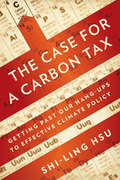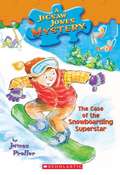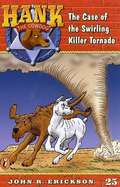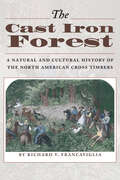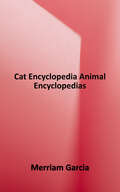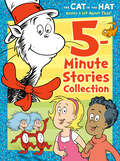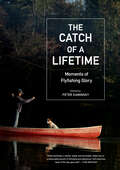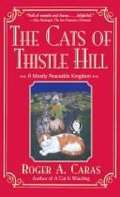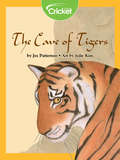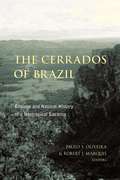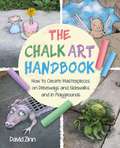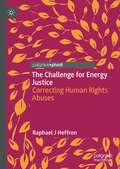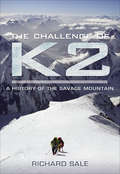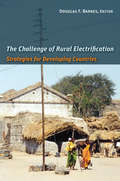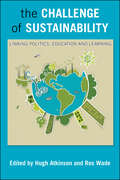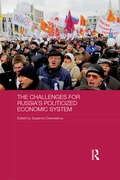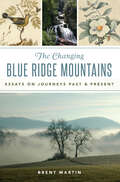- Table View
- List View
The Case for a Carbon Tax: Getting Past Our Hang-ups to Effective Climate Policy
by Shi-Ling HsuThere's a simple, straightforward way to cut carbon emissions and prevent the most disastrous effects of climate change-and we're rejecting it because of irrational political fears. That's the central argument of The Case for a Carbon Tax, a clear-eyed, sophisticated analysis of climate change policy. Shi-Ling Hsu examines the four major approaches to curbing CO2: cap-and-trade; command and control regulation; government subsidies of alternative energy; and carbon taxes. Weighing the economic, social, administrative, and political merits of each, he demonstrates why a tax is currently the most effective policy. Hsu does not claim that a tax is the perfect or only solution-but that unlike the alternatives, it can be implemented immediately and paired effectively with other approaches. In fact, the only real barrier is psychological. While politicians can present subsidies and cap-and-trade as "win-win" solutions, the costs of a tax are immediately apparent. Hsu deftly explores the social and political factors that prevent us from embracing this commonsense approach. And he shows why we must get past our hang-ups if we are to avert a global crisis.
The Case for the Green New Deal
by Ann PettiforWhat is the Green New Deal and how can we afford it?To protect the future of life on earth, we need to do more than just reimagine the economy—we have to change everything. One of the seminal thinkers of the program that helped ignite the US Green New Deal campaign, Ann Pettifor explains how we can afford what we can do, and what we need to do, before it is too late. The Case for the Green New Deal argues that economic change is wholly possible, based on the understanding that finance, the economy and the ecosystem are all tightly bound together. The GND demands total decarbonization and a commitment to an economy based on fairness and social justice. It proposes a radical new understanding of the international monetary system. Pettifor offers a roadmap for financial reform both nationally and globally, taking the economy back from the 1%. This is a radical, urgent manifesto that we must act on now.
The Case of the Great Sled Race (Jigsaw Jones Mystery #8)
by James PrellerAfter a huge snowstorm, the neighborhood kids go sledding at Long Hill. Everyone's having a great time--until one of the sleds disappears. Super-sleuth Jigsaw Jones and his partner, Mila, must solve this chilly case. Humorous line drawings throughout.
The Case of the Snowboarding Superstar (Jigsaw Jones Mystery #29)
by James PrellerJigsaw and his family bond during a wintry weekend getaway complete with snowboarding and sledding -- but a real detective, like Jigsaw Jones, is never truly off-duty. When trouble hits the slopes, Jigsaw gears up to solve a puzzling mystery, and all without the aid of his partner, Mila. Can Jigsaw solve the case before his family packs their bags for home?
The Case of the Swirling Killer Tornado (Hank the Cowdog Series, #25)
by John R. EricksonAttacked by an invisible enemy, Hank rushes to the house to make sure his family is safe, but the house is in the path of a killer tornado and Hank gets trapped inside the house.
The Cast Iron Forest: A Natural and Cultural History of the North American Cross Timbers (Corrie Herring Hooks Series #43)
by Richard V. Francaviglia&“A thoughtful, thorough, and updated account of this bio-region&” from the author of From Sail to Steam: Four Centuries of Texas Maritime History, 1500-1900 (Great Plains Research). Winner, Friends of the Dallas Public Library Award, Texas Institute of Letters, 2001 A complex mosaic of post oak and blackjack oak forests interspersed with prairies, the Cross Timbers cover large portions of southeastern Kansas, eastern Oklahoma, and north central Texas. Home to indigenous peoples over several thousand years, the Cross Timbers were considered a barrier to westward expansion in the nineteenth century, until roads and railroads opened up the region to farmers, ranchers, coal miners, and modern city developers, all of whom changed its character in far-reaching ways. This landmark book describes the natural environment of the Cross Timbers and interprets the role that people have played in transforming the region. Richard Francaviglia opens with a natural history that discusses the region&’s geography, geology, vegetation, and climate. He then traces the interaction of people and the landscape, from the earliest indigenous inhabitants and European explorers to the developers and residents of today&’s ever-expanding cities and suburbs. Many historical and contemporary maps and photographs illustrate the text. &“This is the most important, original, and comprehensive regional study yet to appear of the amazing Cross Timbers region in North America . . . It will likely be the standard benchmark survey of the region for quite some time.&” —John Miller Morris, Assistant Professor of Geography, University of Texas at San Antonio
The Cat Encyclopedia (Encyclopedias for Kids)
by Merriam GarciaThis encyclopedia highlights more than 50 different cats. Alongside colorful photographs of both adult cats and kittens, readers learn about the history, appearance, and behavior of various breeds. Features include information about cat care, a glossary, additional resources, and an index. Aligned to Common Core Standards and correlated to state standards. Abdo Reference is an imprint of Abdo Publishing, a division of ABDO.
The Cat in the Hat Knows a Lot About That 5-Minute Stories Collection (Dr. Seuss /The Cat in the Hat Knows a Lot About That)
by Random HouseA fun-filled collection of stories starring Dr. Seuss's Cat in the Hat that can each be read aloud in five minutes!Nick and Sally have questions about everything from trees to outer space. Luckily, the Cat in the Hat has the answers. Based on the TV series The Cat in the Hat Knows a Lot About That, this hardcover collection of rhyming tales is sure to fascinate and entertain boys and girls ages 3 to 7. Each story can be read in five minutes or less, so they're perfect for bedtime--or anytime!
The Catch of a Lifetime: Moments of Flyfishing Glory
by Peter KaminskyA gorgeously illustrated collection of first-person stories on the sublime joy of flyfishing Every fly fisher has one: that moment—that ineffable, transcendent moment—they can point to and say, That&’s it. That was when time seemed to stop and I felt fully alive. That&’s why I fish. Collected and framed by the award-winning writer Peter Kaminsky, The Catch of a Lifetime presents the moving first-person stories of more than seventy anglers recounting their catch of a lifetime. With its tales of brown trout in Montana and bluefish at Montauk Point, smallmouth in Minnesota&’s Boundary Waters and unforgettable adventures with giant taimen on the steppes of central Asia, bonefish in New Caledonia, white marlin in the Baja, and golden dorado in the tribal lands along the Amazon&’s headwaters, this gorgeously illustrated anthology is a transporting testament to the call that all anglers heed—to get out there and be one with the water. It distills perfectly the magic of the sport; you can&’t read it and not want to go fishing. The contributor list is a diverse who&’s who of writers, artists, sportspeople, and others who&’ve made flyfishing a singular passion, including Carl Hiaasen, Joan Wulff, Tom Colicchio, Charles Gaines, Rachel Maddow, Mark Kurlansky, Brittany Howard, John McPhee, Verlyn Klinkenborg, and Jared Zissu. Their encounters, their memories, the words they use to describe, say, a forty-pound salmon leaping into the air or the sight of a great blue heron soaring down the creek to steal a catch make this the book of a lifetime for any fly fisher.
The Cats of Thistle Hill: A Most Peaceable Kingdom
by Roger A. CarasFrom the book jacket: The cats of Thistle Hill are the ten-plus cats who live with Roger Caras and his family on their farm in Maryland-along with dogs, horses, birds, cows, and even a llama. Thistle Hill itself is as much a character in The Cats of Thistle Hill as are the cats, with its secret tunnel, barn, pastures and streams, and the staff of workers who care for the thirty-odd animals and the farmhouse and surroundings full-time. In this charming book, cat lovers will meet some of the most memorable felines ever found between covers-Teddy, who holds court in a private room in Caras's house; Xnard, who survived an LSD experiment before being rescued by the the author's son; and Omari, a tomcat who brings back some pretty strange objects from his wanderings around Caras's farm. Each cat has a different history and each illustrates some truths about what cats need and expect from us and what we need and expect from cats. Throughout the book are photographs of the animals of Thistle Hill and of the daily routine of life on the farm. The Cats of Thistle Hill also provides fascinating information for cat owners or those who are thinking about ownership, including valuable sections on feline breeds, behavior, and diseases, with plenty of practical information on topics such as choosing a cat, neutering and spaying, and immunizations. Animal lovers of all kinds will find much to enjoy in The Cats of Thistle Hill With wit and humor, and in charming and telling detail, Roger Caras offers a memorable account of life in the "mostly peaceable kingdom" of Thistle Hill. ROGER A. CARAS is the eighteenth president of the American Society for the Prevention of Cruelty to Animals, the ASPCA, the oldest humane organization in the Western Hemisphere. Prior to taking on the leadership of the "A," he was with ABC Network for seventeen years, the only correspondent with any network to have the title Special Correspondent for Animals and the Environment. He is the author of more than sixty books. A selection of the Book-of-the-Month Club
The Cave of Tigers
by Jez PattersonA young boy and a tiger visit a cave filled with paintings of tigers. There's even a picture of a tiger hunting a mammoth!
The Caves Beyond: The Story of the Floyd Collins' Crystal Cave Exploration
by Roger W. Brucker Joe Lawrence Jr.THE CAVES BEYOND by Joe Lawrence, Jr. and Roger W. Brucker The Caves Beyond is the classic American caving adventure story. There is no other caving book like it. First published in 1955 in an edition of 10,000 copies, the book was out of print soon afterwards. It is now known among caving enthusiasts as the most stolen book there ever was. You will see it listed in most library catalogs, but will be lucky to find a copy on a library shelf. In February, 1954, under the direction of Joe Lawrence, the National Speleological Society sent the largest, most highly organized, and best-equipped expedition in the history of American cave exploration into Floyd Collins' Crystal Cave, Kentucky. The Caves Beyond is the official NSS account of that expedition. In the short view, the C-3 (Collins' Crystal Cave) expedition was not much of a success, but in the long view it was a major turning point in American speleology. Three cavers- Phil Smith, Roger Brucker, and Roger McClure, emerged from the C-3 expedition to organize the Central Ohio Grotto Flint Ridge Reconnaissance, and then the Cave Research Foundation, to carry on the exploration. Guided by Jim Dyer, Dr. Pohl, and Bill Austin, they molded the most concentrated speleological effort ever undertaken by a large group. Planning for the C-3 expedition had begun in 1952; 20 years later, with no letup in intensity, the big connection between the Flint Ridge Cave System and Mammoth Cave was made. The story told in The Caves Beyond culminated in the integration of the longest cave in the world-the Flint Mammoth Cave System. Roger Brucker's new introduction to the long-awaited reprint edition reveal a number of old secrets, including stories of the politics behind the C-3 expedition and of how the book came to be written in an attic in Brooklyn in two weeks' time. There is also a detailed index, which the first edition lacked.
The Central Appalachians: Mountains of the Chesapeake
by Mark Hendricks--The book will be the first to specialize on the Appalachians of the Chesapeake Bay Watershed. --Interspersed amongst seasonal portfolios of images will be stories of characters- scientists, conservationists and a thru hiker on the Appalachian Trail. No other project on these ancient mountains has used traditional photography as well as camera trapping, underwater photography, and drones to attempt to tell a complete story. --Tourism is booming in the mountains and this could be an important compilation for the four states that it documents
The Cerrados of Brazil: Ecology and Natural History of a Neotropical Savanna
by Paulo Oliveira Robert MarquisWhile the imperiled Brazilian rainforest has been the focus of considerable international media attention and conservation efforts, the massive grasslands of Brazil—known as the cerrados—which cover roughly a quarter of its land surface and are among the most threatened regions in South America, have received little notice. This book brings together leading researchers on the area to produce the first detailed account in English of the natural history and ecology of the cerrado/savanna ecosystem. Given their extent and threatened status, the richness of their flora and fauna, and the lack of familiarity with their unique ecology at the international level, the cerrados are badly in need of this important and timely work.
The Chagos Archipelago: A Biological Biography
by Charles SheppardThis book is the story of the natural history of Chagos Archipelago, and of the efforts of many to get it recognized as an important and protected wildlife reserve. Exploring its immense natural riches and biodiversity, both on islands and in the marine environment, this book addresses competing claims to its resources, its politics, and the desire of some commercial and political parties to exploit the area. It is about the fight to conserve a wonderland of biodiversity and obtain its protection from exploitation, especially of its reefs and other marine life. This book shows the importance of the Chagos Archipelago and why so much research was done there. Rather than being a typical research book, this work presents research in a narrative form and describes the now substantial Government, UN, and legal interest in the archipelago since the UK was told to ‘decolonise’ it. It is also the story of our planet in miniature: the archipelago encapsulates much of the world’s conservation tribulations in a way we can much more easily understand. This narrative will explore the difficulties faced by the Chagos Archipelago, including displaced people, old and derelict industries (coconut in this case), the military, politics, rich and untouched ecosystems that some want to exploit, ruined habitats on land, climate change, and territorial claims. It will examine how all of these factors have affected the natural history, biodiversity, and conservation of the archipelago. With beautiful photography of the Chagos Archipelago coral reefs and islands, as well as graphs indicating their findings, this book offers professionals, researchers, academics, and students in conservation and biodiversity an insight into one of the world’s most diverse ecosystems. It is also accessible for non‑academic readers with an interest in climate change, biodiversity, and the importance of conservation.
The Chalk Art Handbook: How to Create Masterpieces on Driveways and Sidewalks and in Playgrounds
by David ZinnA comprehensive guide for chalk art creators! With so many searching for ways to have fun at home in the midst of the Covid-19 pandemic, chalk art has become a great way to do so while enjoying some fresh air. The Chalk Art Handbook offers budding artists a review of the tools involved, as well as tips and tricks to creating an array of sidewalk creatures. Artist David Zinn, whose work has been used as inspiration for elementary and middle school art lessons, offers step-by-step guidance on how to make chalk art come to life and advice on specific techniques such as smudging, perspective, and 3-D illusions. He also encourages artists to work outside the box with details on how to best incorporate concrete specks and natural holes or cracks in the ground into their artwork. The Chalk Art Handbook even includes bonus activities to keep everyone drawing happily both indoors and outdoors. The perfect gift for those looking for hours of outdoor fun!
The Challenge for Energy Justice: Correcting Human Rights Abuses
by Raphael J HeffronWritten by one of the world’s leading scholars in the field, this book provides a unique perspective on the connections between energy justice and human rights. Taking an interdisciplinary approach, the author offers an accessible discussion about the implementation of energy justice in practice. The book explores the rise of justice issues in the energy sector, the interdisciplinary nature of energy justice, the economics of energy justice and provides a practical case study on distributive justice. The penultimate chapter focuses on human rights and energy justice in a world first, and explores the topic from the perspective of the opportunity of last resort. This ‘opportunity of last resort’ is the national courts and is the place where societies can seek to have justice enforced through a variety of human rights being protected. Finally, energy justice risks are highlighted alongside the author’s proposed framework for the next generation of energy justice scholars.
The Challenge of Climate Change: Which Way Now?
by Daniel P. Perlmutter Robert L. RothsteinGlobal warming and climate change present complex interlocking issues of public policy, multilateral negotiation, and technological advancement. This book explores both the problems and the opportunities presented by international agreements, and examines the technological developments and policy goals that can be pursued to effect the changes necessary. Specific steps are proposed in the form of a list of priorities. This book represents a cooperative enterprise between two authors of different backgrounds - engineering and international relations - and is directed to an educated but non-professional lay audience without any formal training in either science or international relations. The points of view of negotiators from both developed and developing nations are presented and compared. Each topic is presented from both technical and policy perspectives as a means to evaluate the variety of proposals that have been offered as remedies to global warming. The text is supported by illustrations and tables where appropriate, including a list of References at the end of each chapter.
The Challenge of K2: A History of the Savage Mountain
by Richard SaleK2 is a legend - one of the most demanding mountaineering challenges in the world and one of the most treacherous. Extreme, unpredictable weather and the acutely difficult climbing conditions test the technique, endurance and psychological strength of the most experienced mountaineers to the limit and often beyond. Many of the men and women who have sought to reach the summit have failed, often with tragic consequences - over 70 of them have died or disappeared. Yet this, the second highest mountain on Earth, continues to exercise for the worlds top mountaineers a special, and all too often lethal attraction. Richard Sales fascinating new book traces the climbing history of K2 over the last 150 years, he shows in graphic detail how it acquired this awesome reputation: it was during the first serious attempts on the summit in the 1930s and 1950s that K2 became known as the Savage Mountain.
The Challenge of Rural Electrification: Strategies for Developing Countries
by Douglas F. BarnesDouglas Barnes and his team of development experts provide an essential guide that can help improve the quality of life to the estimated 1.6 billion rural people in the world who are without electricity. The difficulties in bringing electricity to rural areas are formidable: Low population densities result in high capital and operating costs. Consumers are often poor, and their electricity consumption is low. Politicians interfere with the planning and operations of programs, insisting on favored constituents. Yet, as Barnes and his contributors demonstrate, many countries have overcome these obstacles. The Challenge of Rural Electrification provides lessons from successful programs in Bangladesh, Chile, China, Costa Rica, Mexico, the Philippines, Thailand, and Tunisia, as well as Ireland and the United States. These insights are presented in a format that should be accessible to a broad range of policymakers, development professionals, and community advocates. Barnes and his contributors do not provide a single formula for bringing electricity to rural areas. They do not recommend a specific set of institutional arrangements for the participation of public sector companies, cooperatives, and private firms. They argue instead that successful programs follow a flexible, but still well-defined set of principles: a financially viable plan that clearly accounts for any subsidies; a cooperative relationship between electricity providers and local communities; and an operational separation from day-to-day government and politics.
The Challenge of Sustainability: Linking Politics, Education and Learning
by Hugh Atkinson and Ros WadeThis timely and accessible book explores the links between politics, learning and sustainability. Its central focus is the future of people and the planet itself. The challenges that we face in combatting climate change and building a more sustainable world are complex and the book argues that if we are to successfully meet these challenges we need a fundamental change in the way we do politics and economics, embedding a lifelong commitment to sustainability in all learning. We have no option but to make things work for the better. After all, planet earth is the only home we have! The book will be important reading for academics and students in a variety of related subjects, including politics, public policy, education, sustainable development, geography, media, international relations and development studies. It will also be a valuable resource for NGOs and policy makers.
The Challenge of the Sea
by Arthur C. ClarkeWhile tremendous strides toward the conquest of space occupy most of today's headlines, scientists are also exploring the vast secret recesses of the sea. Clarke takes us beneath the sea...
The Challenges for Russia's Politicized Economic System (Routledge Contemporary Russia and Eastern Europe Series)
by Susanne OxenstiernaDuring the early 2000s the market liberalization reforms to the Russian economy, begun in the 1990s, were consolidated. But since the mid 2000s economic policy has moved into a new phase, characterized by more state intervention with less efficiency and more structural problems. Corruption, weak competitiveness, heavy dependency on energy exports, an unbalanced labour market, and unequal regional development are trends that have arisen and which, this book argues, will worsen unless the government changes direction. The book provides an in-depth analysis of the current Russian economic system, highlighting especially structural and institutional defects, and areas where political considerations are causing distortions, and puts forward proposals on how the present situation could be remedied.
The Changing Arctic Environment
by David P. StoneThis accessible and engagingly written book describes how national and international scientific monitoring programmes brought to light our present understanding of Arctic environmental change, and how these research results were successfully used to achieve international legal actions to lessen some of the environmental impacts. David P. Stone was intimately involved in many of these scientific and political activities. He tells a powerful story, using the metaphor of the 'Arctic Messenger' - an imaginary being warning us all of the folly of ignoring Arctic environmental change. This book will be of great interest to anyone concerned about the fate of the Arctic, including lifelong learners interested in the Arctic and the natural environment generally; students studying environmental science and policy; researchers of circumpolar studies, indigenous peoples, national and international environmental management, and environmental law; and policymakers and industry professionals looking to protect (or exploit) Arctic resources.
The Changing Blue Ridge Mountains: Essays on Journeys Past and Present (Natural History)
by Brent MartinExplore this section of the Appalachians in these essays examining its history, its wilderness, and what change means for its future.In the eighteenth century, naturalist and artist William Bartram traveled in the Blue Ridge Mountains and spent time documenting both plant life and the customs of the Middle Town Cherokees. Since that time, men and women like Bartram have journeyed through Western North Carolina&’s wildest and most remote places and written about their experiences. The essays in this volume compare the present day to those historical journeys and explore the idea of wilderness and what change means for the future of the people and the species who live in the mountains. Join local writer and guide Brent Martin on a journey through this incredible landscape.&“With unflinching candor, Brent Martin celebrates the heartbreaking beauty of Appalachia. He wrings out every sensory and emotional detail in these passionate, probing essays that explore the wild within. These aren&’t lyrical paeans to nature; they are gritty, gutsy journeys into the rugged, remote landscapes of the human heart. Immersed in mountain tradition, culture, and community, he wanders deep and alone into the wild to find what remains. Martin&’s powerful, masterful writing shines with real, hard-earned hope.&” —Will Harlan, author of the New York Times bestseller Untamed: The Wildest Woman in America &“If you love the Southern Appalachians and Wendell Berry and Annie Dillard and Gary Snyder, read this beautifully written and deeply thought-provoking book.&” —Charles Frazier, author of the New York Times bestseller Cold Mountain&“A thoughtful and thought-provoking collection of essays from one of Appalachia&’s staunchest proponents of wilderness and one of its most devoted writers. Brent Martin is a preeminent naturalist and a scholar of the history of his place. This book is deeply personal, highly instructive, far-reaching.&” —Janisse Ray, author of Ecology of a Cracker Childhood&“A loving a troubling portrait of the southern Appalachians—the rich history and complexity of ecosystems alongside the damage we&’ve wrought on them.&” —Catherine Reid, author of Falling into Place: An Intimate Geography of Home
